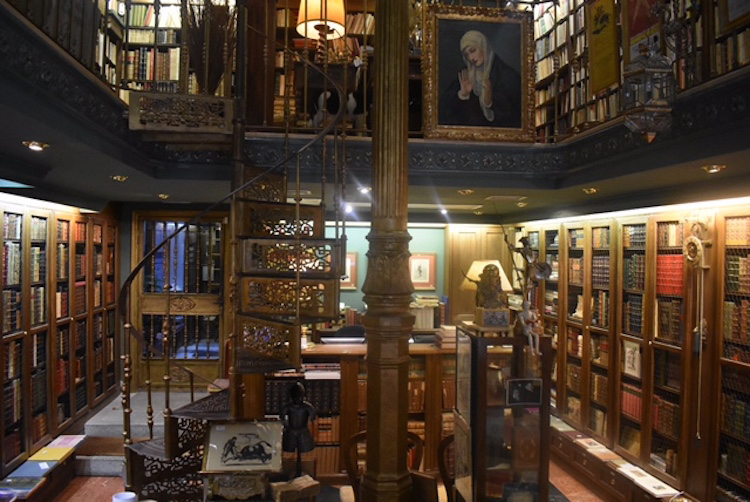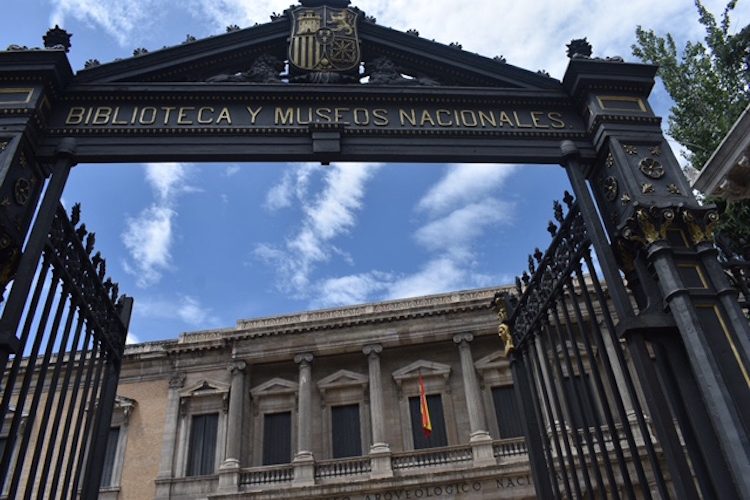Whether you’re a book worm or not the Biblioteca Nacional (National Library) and Museum is worth a visit when you come to Madrid. Some of the oldest collections in the library are the Leonardo da Vinci’s Madrid Codices, Miguel de Cervantes’ archives, the Metz Codex and eleventh century manuscript Beato de Don Fernando
Not only does it contain the literary significance of Spain, but is also rich in history, music and culture. There are many other antique manuscripts, newspapers, books, music scores, coins, maps, engravings, photographs. The library and museum are ways to see the evolution of society through the progression of books, writing and printing over time.

Entrance to the National Library’s museum | Courtney Buble
King Philip V of Spain founded the library in 1712. He required a copy of every book printed to be stored here. Originally it was called the Palace Public Library. Then, in 1836 it went from Crown property to ownership of the Ministry of Governance. Today it is the largest library in Spain and one of the largest in the world.
The collection of Cervantes archives is one of the main attractions of the Biblioteca Nacional and Museum. Considered the most famous work from the Spanish Golden Age of Literature and the first modern novel, Don Quixote, by Miguel de Cervantes, has had a profound effect on Western fiction. You can’t come to Madrid without learning about this novel as Cervantes lived and worked here from 1607 until his death in 1616.
The Biblioteca Nacional has many functions. Among them are: collecting, classifying, categorizing, preserving, reproducing and exchanging documents, books, and anything else. According to a 2006 census, mentioned in the museum, there were 20 million documents. The library is the main preserver of Spanish culture and history in the country.
If you come to Madrid during the summer you may not be able to see the inside of the library because it is only open to researchers and select tours (which you must book in advance). However, the museum attached to the library provides a comprehensive overview of the history of its contents and the evolution of books, writing, and printing.
While the museum is in Spanish, there are translation cards for each exhibit in many languages. Such information is also available online, as noted by the library’s press office. The halls of the museum are the history of the library, what the library does, writing and its materials, display of original works, record keeping over time, literary cafés and evolution of bookbinding and publishing.
The library regularly switches out its collection of original works in the museum. Some of the authors on display currently are: Miguel de Cervantes, Leopoldo Alas “Clarín”( Spanish novelist), Joseph Reyre (Jesuit and French writer), Fernando de Rojas (Spanish author and dramatist) and Wenceslao Agguals de Izco (Spanish writer and editor). There are also old newspapers that have been preserved, such as an issue of La Iberia from Sept. 30, 1674.

Bookstore in the lobby of the museum | Courtney Buble
Before leaving the museum, be sure to check out the Librería de la Biblioteca Nacional de España (bookstore of the National Library of Spain). There you will find a variety of books–old and new–to suit your reading preferences. Madrid native Enrique Sanz, who works for the Con Tarima in Las Letras neighbourhood, explained that this store supplies the books.
Among the Prado, Retiro and el Rastro, the Biblioteca Nacional and Museum is a great attraction to learn more about this city and Spanish literary culture. Make sure this lesser-known spot is on your list, even if it’s just to escape the summer heat for a little.
Biblioteca Nacional; Paseo de Recoletos, 20-22; Summer Hours: Tuesday to Saturday from 10:00 a.m. to 8:00 p.m. and Sundays and holidays from 10:00 a.m. to 2:00 p.m; Metro Colón.
Travel Journalism, Photography & Video Internship Seminar in Madrid, Spain

